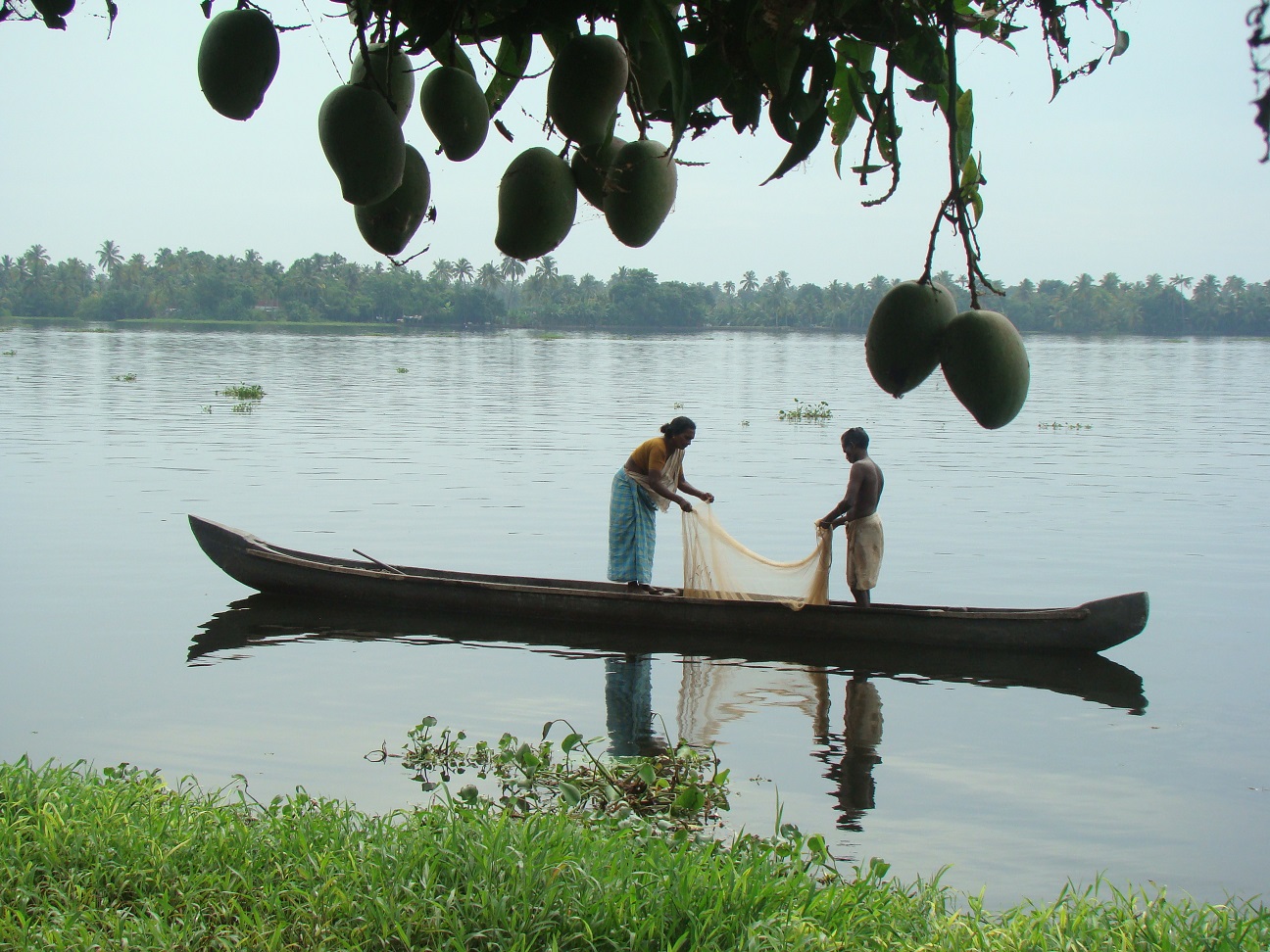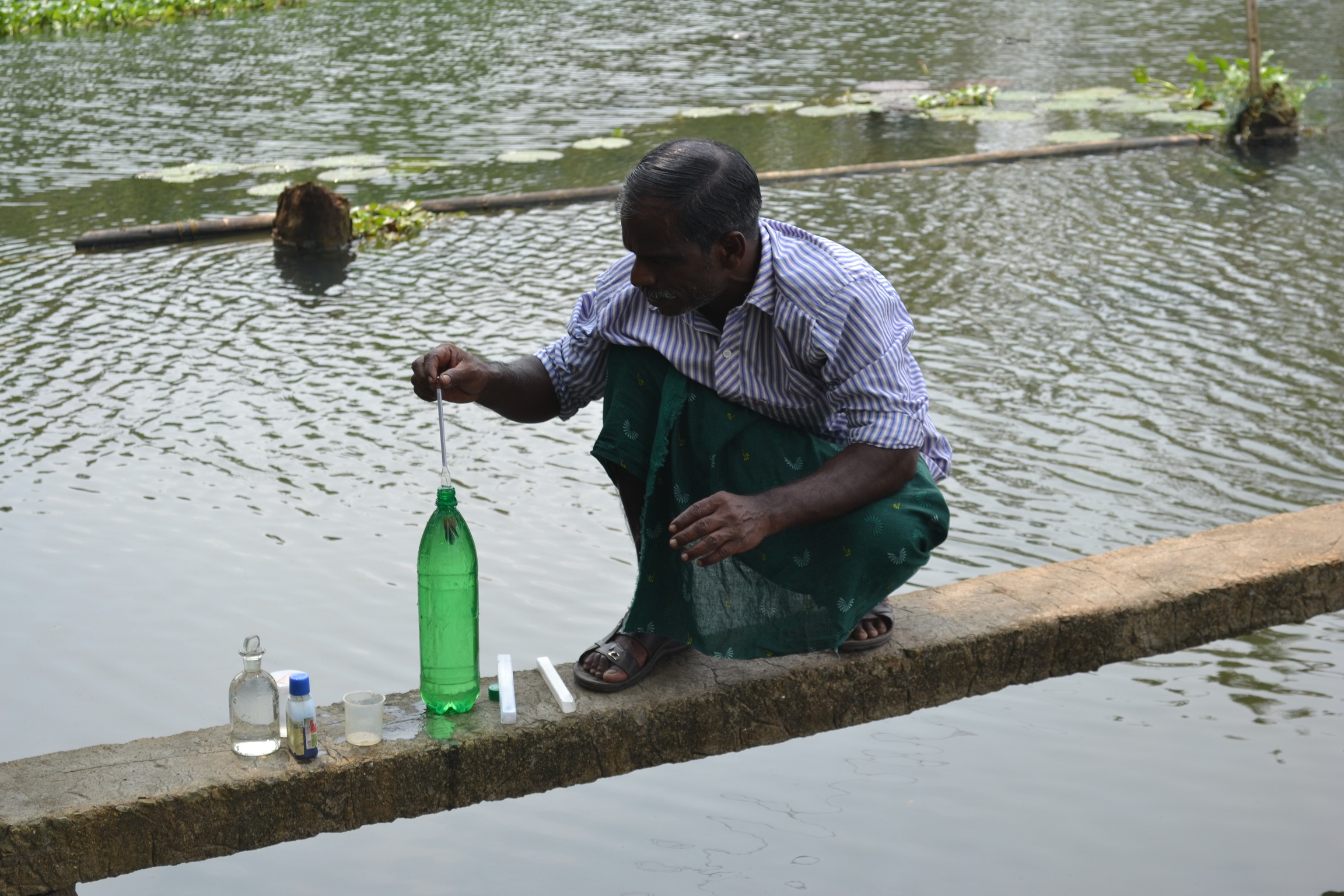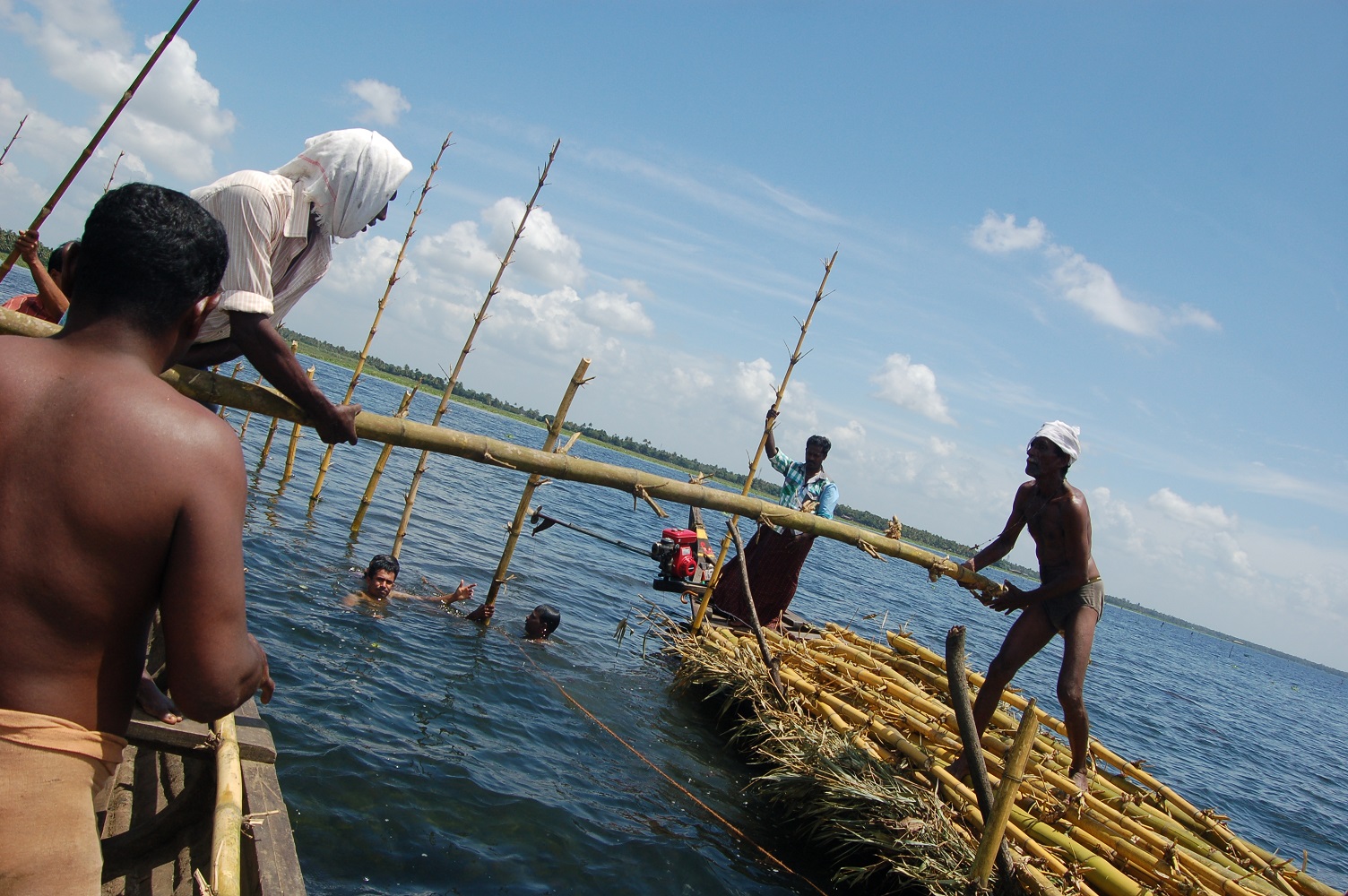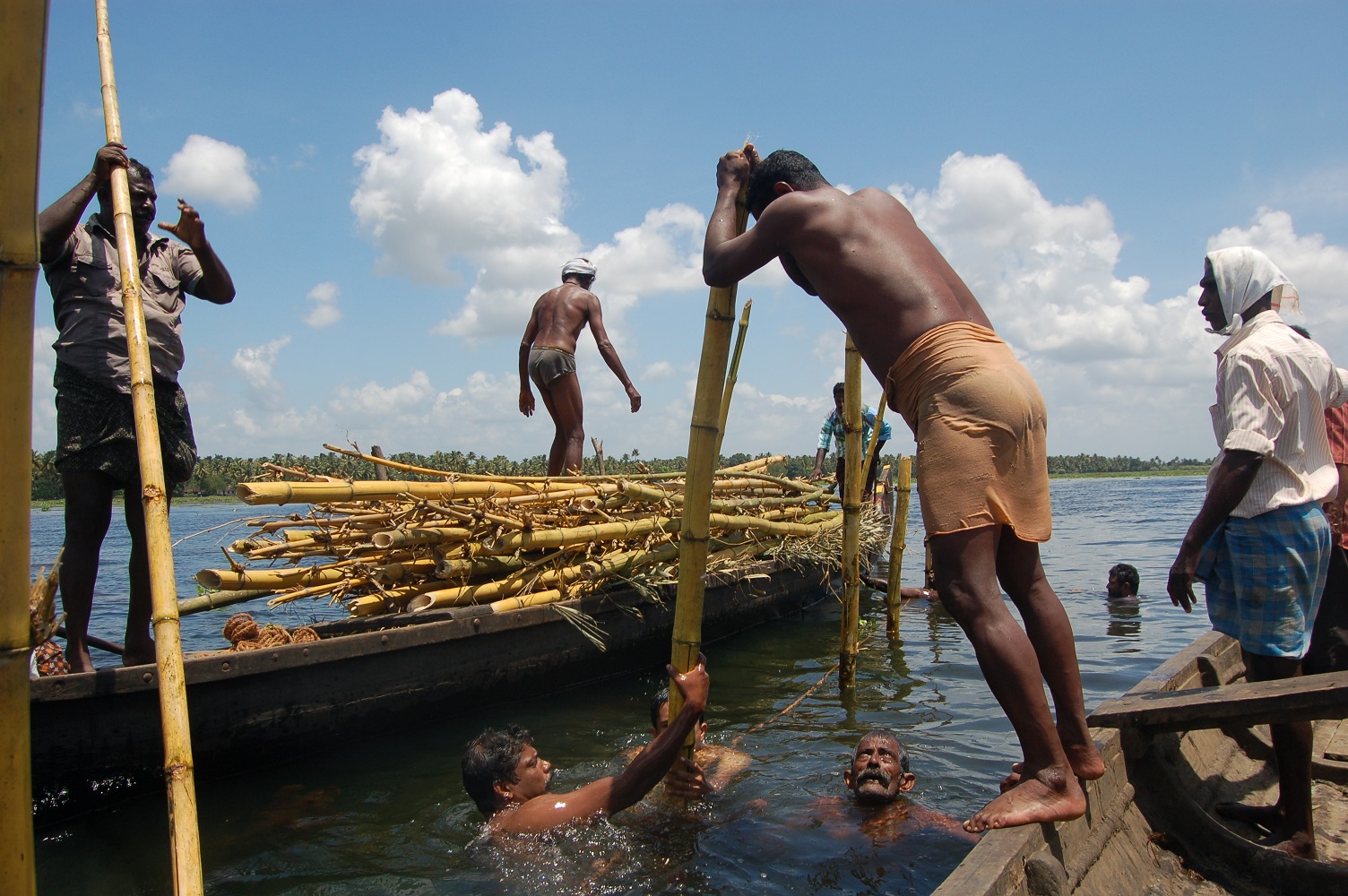For generations, right before dawn, Pavithran’s ancestors have rowed a narrow, wooden boat from a thin canal out into the dazzlingly bright and bountiful lake. Fishing and collecting clams from the bottom of the lake, they are back before noon. Pavithran and his wife engage in a set of finely synchronised movements that sort the clams. While the clams boil in a large vat, Pavithran’s wife scoops and throws them on the sieve. The meat from the clams plops through thickly as he sieves out the shells in an elegant swoop of his arm. The clams clink as they fall on a wet sack.
Pavithran talks about his dwindling catch, about its shrinking diversity, and how pollution and unethical fishing practices have affected breeding of fish and clam. “If the water is clean, karimeen [pearl spot] can produce up to 20,000 seedlings, now they are down to 1,000,” he says. “Fish breeding is badly affected by polluted waters. Wouldn’t you be stunted if you grew up in pollution?”
Finishing up, Pavithran says he never catches baby clams “because we want to fish tomorrow also”. He partly blames the closure of the local coir industry for it, whose castaways recklessly harvest anything they can get with no concern for sustainability, as well as the exploding tourism industry. “Everyone understands only money – that is the only value anyone sees in this lake,” he says.
Fishing in Vembanad
Photo credit: KA Kishore
Around him, wispy spirals of smoke from a neighbour’s clam boilers lift up like mini tornadoes. Just a few steps away is the lake shore – a complex wetland system that is complicated further by the diverse use of resources by several communities along its 84-km long stretch that hugs India’s western coast. Over 1.6 million people in 38 panchayats depend on it for agriculture, fishing, tourism, navigation, clam collection, etc. On the ecological side, it is India’s largest Ramsar site (wetlands of international importance) that supports the third largest wintering waterfowl population and is home to significant mangrove patches as well as endangered fish species.
Spread over 36,000 hectares and three districts in Kerala, this is the kind of landscape that gives conservation ecologists a blinding headache – a resource-rich, highly-productive area that is pulled apart in several directions (waste-dumping, tourism, livelihoods, water security) and depended upon by conflicting communities who have no other alternatives. Lakes have been straddling this intersection all across India – from Chilika in Odisha, to the Bengaluru urban lakes, to Loktak in Manipur, to Vembanad.
Such heavy-use landscapes outside protected areas, however, also might hold answers to the future of conservation. Whether it is a large lake system, or forest fragments that serve as the refuge of a few species or a corridor for wild animals, or a forest fringe, or large agricultural swathes that also host biodiversity, a section of conservationists believes that the future lies in teamwork between nature and mankind.
The Vembanad system of backwaters, lagoons and estuaries is crisscrossed by canals, rivers and marks of human use. But to conserve and restore the biodiversity and integrity of the life-sustaining nature of Vembanad Lake, it might be wiser not to try to untangle this messy co-dependence but to accentuate it. Perhaps because, when visible, such a mesh of linkages shows us how we fit into an ecosystem and the balance of roles.
But when such a large canvas is dotted with myriad problems, where does one begin? Across the narrow canal from Pavithran lives KM Poovu, another traditional fisherman, who knew one place to start. And it was all contained in a small plastic bag.
Clamming up the data
The little bottles tinkled against each other as Poovu, 59, secretary of Federation of Lake Protection Forums, walked to the canal to test the water’s pH level. He was demonstrating his water quality kit. Three years ago, Poovu learnt how to test the lake’s water for pH, salinity, total dissolved solids, dissolved oxygen – markers that informed him of the water quality, especially salinity.
Water quality monitoring
In the late 1970s, the lake was physically divided into two parts, north and south, to be controlled by the Thanneermukkom Barrage. The gates, when closed, separate the southern part (132 sq km), towards Alleppey, to reduce the salinity and help paddy cultivation that needs freshwater. But the reduced salinity adversely affects the catch of several species such as freshwater prawns, shrimps and clams, and reduces natural flushing of the lake. Pavithran blames the barrage for the change in ecology and catch. Between fish counts in the early 1970s and now, species diversity has fallen from 150 to 70.
Meghanathan KV, president of the black clam marketing society at Muhamma, panchayat member (Mannancherry) and block Congress committee president, says, “There was no problem before the barrage. The barrage is highly politicised as the paddy farmer group is more powerful and organised.” The timing of opening and closure of the gates is critical – it remains open in the monsoon to let the extra water from upstream rivers drain out into the sea and closed otherwise to prevent ingress of seawater (October to March). The timing is also the conflict – the farmers want it closed, the fishermen don’t.
Some years ago, Atree, a Bengaluru-based conservation research institute, introduced the water quality programme, called Jaladarpanam, that is practiced by Poovu. It empowered the fisherfolk with data to fight for their right. Poovu and the Lake Protection Forums (Kayal Samrakshana Samithi) used this information of reduced salinity and increased pollution to send press releases to local papers and lobby the collector and the barrage committee, and succeeded. Meghanathan says it has at least made the barrage open on time and not as late as April.
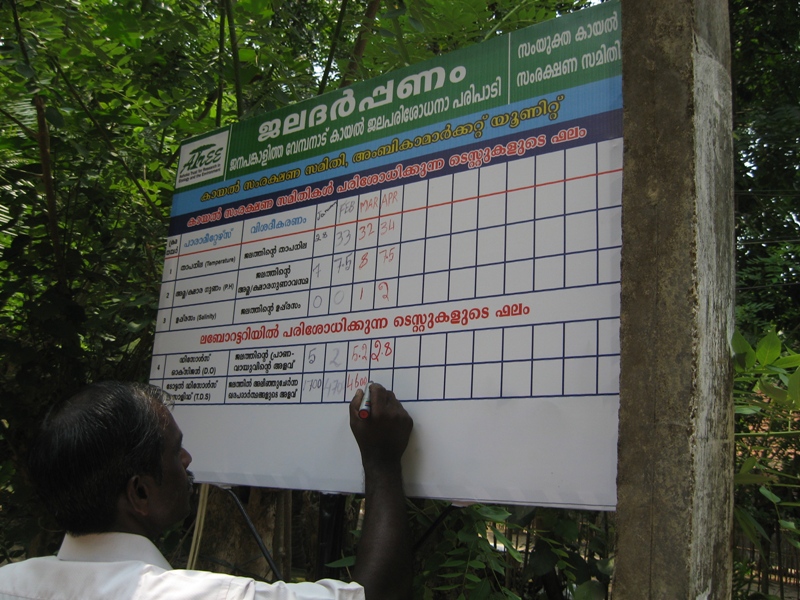
Water quality monitoring
Sharing a lunch of Karimeen and sardines, Poovu, a quiet, reflective person, remembers how clear the lake is when the barrage opens, and how abundant the clam catch. “The testing gave a new ideology to people,” he says. “People should know how salinity affects them and they made awareness their resource. The water quality boards led to discussions. Even the collector was not aware of it.”
A sanctuary for fish
Another ideology changed within the fishing community in the 15 Lake Protection Forums of 250 members each. The falling catch, over-fishing, dredging, disappearance of mangroves, unethical practices made the exploiters turn into protectors. Atree in its work with the Forums did not want to impose solutions from outside, instead it wanted the community to find its own. They found one answer in fish sanctuaries.
A fish sanctuary
Rajapen, 51, has been fishing since he was 11. For those 40 years, he knew and practiced a method of fishing known as Paddal fishing or bush-bark fishing. It involves sinking bundles of foliage of mango and cashew, which over time create a plankton bloom, providing the right conditions for fish to feed, breed and hide their babies. Fishermen would then encircle these microhabitats and catch everything. Priyadarsanan Dharma Rajan, a senior fellow with Atree who spearheads the lake programme, says that it was an elderly fisherman who turned the idea on its head, transforming its function from hunting to harbouring. These paddals, if kept in a safe area, turn into fish harbours, called Matsyathavalam (fish shelter). These modified structures were placed on the lakebed and protected by bamboo fencing. These shelters are declared as non-fishing zones and Lake Protection Forum members take turns to keep vigil.
A fish sanctuary
Rajapen rows out his boat and points at one. From the boat it just looks like a submerged bamboo Stonehenge but underneath the water, rich fish life writhes and grows. The boat bobs gently as a large white motorboat passes. Rajapen says these are the kind of boats he has to protect his fish babies from. The shelter now provides him and other fisherfolk from his village, Varanam, with sufficient catch. They use large mesh nets to trawl in the adult fish, and even giant prawns. Back on shore, the path is cobbled with clam shells; so ingrained that it feels like a mosaic underfoot. Rajapen stops and says, “What we are doing is pretty small. We realised that we needed to do this because our lives were getting affected. Bad fishing practices are still rampant but we fight against it.” The Lake Protection Forums have managed to reduce baby clam fishing, dredging and regulated fish net size. Poovu also published a book on ethical practices for the fisherfolk. Jojo TD, project coordinator with Atree, says that it matters who says it, “When someone like Poovu, also a fisherman, writes and tells them about it, they say, ‘It is our Poovu’s book’. The sense of pride comes from within. It is not an NGO coming with a brochure.”
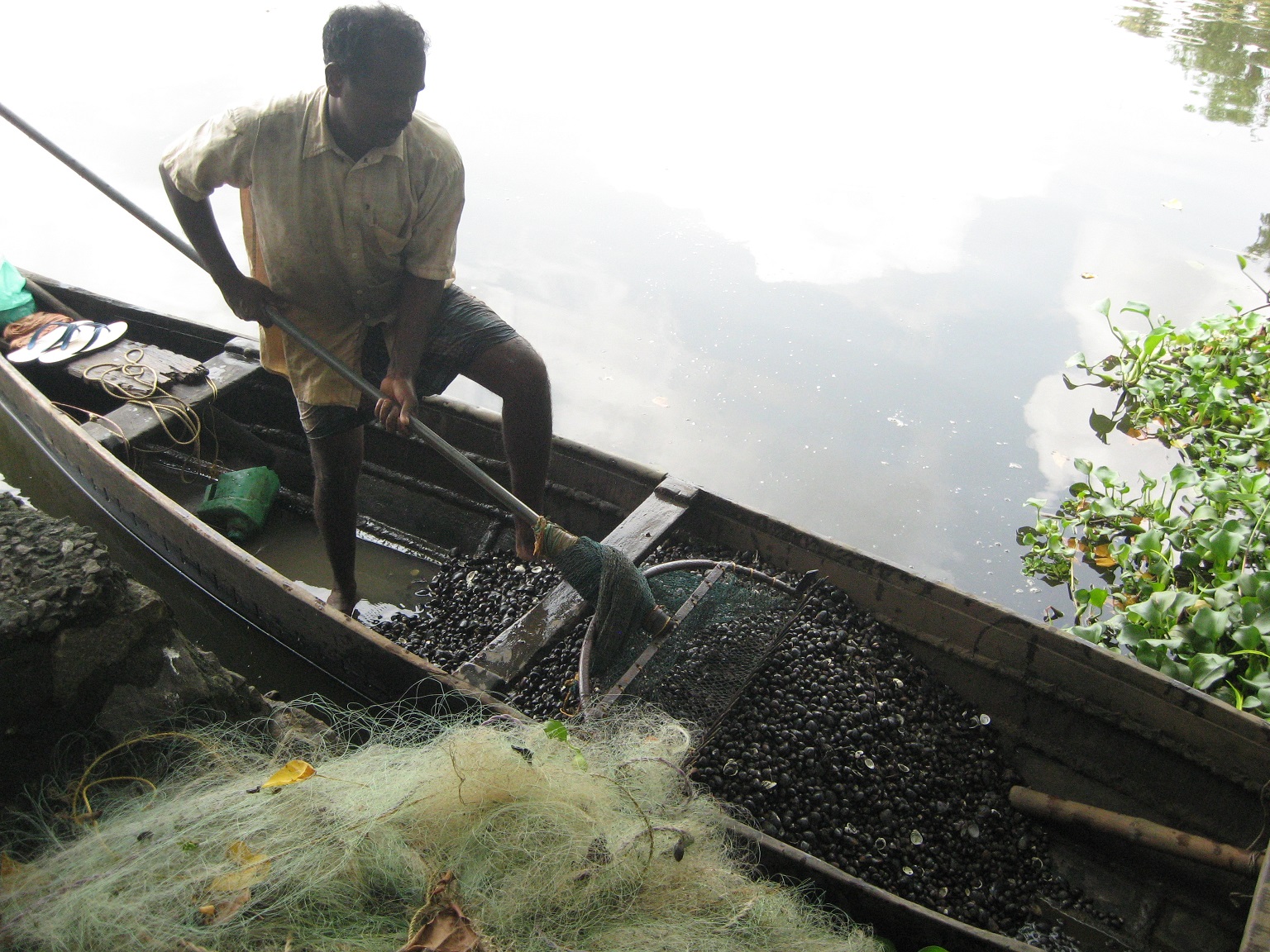
Clam processing
The dredging fight got much worse last year when groups came with mechanised dredgers to harvest clams in large numbers. Ecologically, clams play an important role in flushing the lake of impurities. Over-harvesting has an impact on water quality and the ecosystem. Dinesh, 45, a fisherman from village Kannankara, says that it started last year in June. “Mechanised dredging is illegal,” he says. “Water becomes acidic and fish die. Clams start bursting out of their shells. And they did it at night.” The Lake Protection Forums came out together to oppose the dredging, called the police, involved the local government and filed cases, which are still on. For now, the dredgers have left. Dinesh says neither political parties nor trade unions saw to their problems. “What’s the point if they don’t help? I think they can come back but we have to stick together to remain confident,” he says.
Why is conservation a dirty word?
Eight years ago when Rajan came to this area, there was no cohesion among the fisherfolk even though they were besieged by reduction in catch – down from 16,000 tonnes a year in late 1970s to 4,390 tonnes in 2013 (north and south). Clam collectors, who are the poorest, were badly affected by the scoop net technique. Earlier clam fishing was a highly skilled deep-diving job but not anymore. Tourism was exploding and pollution rocketing. But Rajan did not want to step in. He just wanted to start a conversation without using the word conservation.
“It is tough to even mention ‘conservation’. It has the interpretation that it will mean loss of access and livelihoods in India; it will be the end. We wanted to change that paradigm. We didn’t want to be the people to make the policy. They should use their own knowledge,” says Rajan. And this came true in the case of the fish shelters, which Jojo says, helped them win their trust.
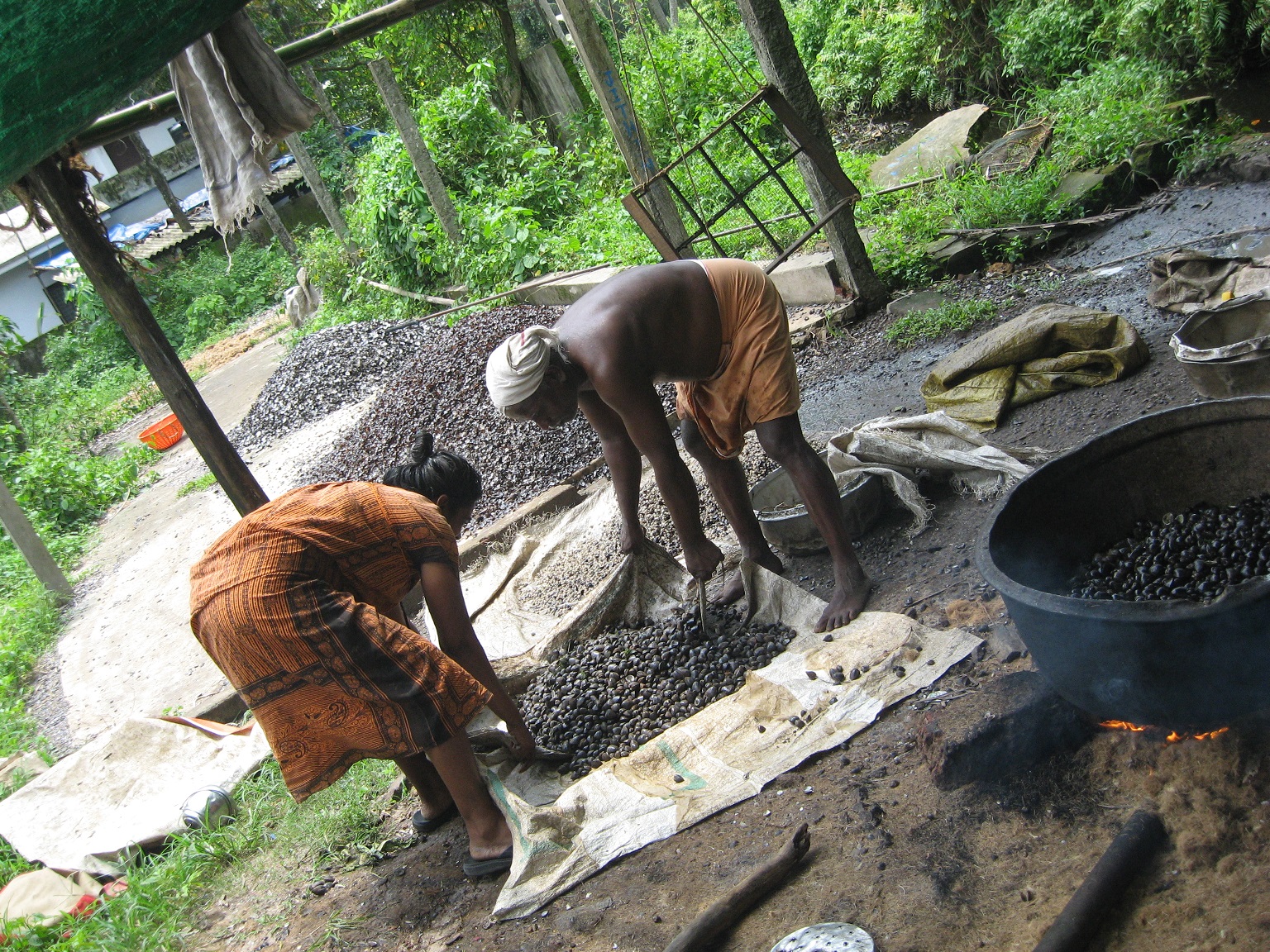
Clam collection
Conservation is not just about roaming remote jungles in search of new species and animal behaviour. Increasingly, it is being shifted to this interface and trust is tough to earn. Jojo remembers when they took their first steps, they started with the revival of a traditional ritual that had been long dead, the Ayilyam-Makom. The fisherfolk ritual involves dedicating seeds to two ancient temples and sprinkling them into the lake, praying for a good harvest. In terms of conservation, says Jojo, it coincides with the north-east monsoon, the breeding time. “It also brought them together not only for the festival but also the well-being of the lake, livelihood and existence,” says Jojo.
The other participant in this effort that Rajan, Jojo and the Lake Protection Forums are leading are the paddy farmers, who are struggling with drinking water. The Kuttanad area, 1,100 sq km of paddy, is the reclaimed part of the lake. This land sits below the water level of the lake and is protected from it by high bunds. All houses face the waterways with the neon-green paddy fields to their back.
Grass cutters
Photo courtesy: Samson Alappuzha
Satheeshan AG, 53, a paddy farmer in Venattukadu village, stands in front of a brand new reverse osmosis plant provided by Atree and talks about how he used to buy 20 litres of water for Rs 50. Satheeshan’s house is surrounded by spans of blue tarpaulin that drain into large drums. He is trying to save every drop of rain that falls around him. “The pollution load in the lake increases every year. Upstream chicken farms dump waste. We could see floating dead chickens. You can feel how bad the water is if you dip your hand in it,” he says about why he decided to buy expensive water from the "water trains" – boats that bring in water tanks – a visible example of water everywhere but none to drink. Satheeshan and his fellow farmers use heavy amounts of pesticide, he admits. “We know that the tonnes of pesticide we use go into the water we now drink. We cannot take a chance on our crop though we have started regulating it,” he says.
Rajan hopes this is the beginning of the conversation about water and conservation consciousness. “People always need to see the benefit in their day-to-day lives,” says Rajan. “If you say ‘save this’, they will ask ‘why’. There is no free lunch, even for nature.”
One cannot help but feel that such anthropocentric conservation practices, critical as they might be, can be dispiriting because the underlying belief is that humankind will always be transactional with nature. That we do not possess the altruism or restrain to let the natural world be just for itself or because they might have a right to do so. This equation works well for a situation like Vembanad, where livelihoods to health to environment are linked almost visibly but not so much for an issue like climate change, where it is difficult to see the effect of logging one forest patch.
Whose responsibility?
Rajan feels their work with the Lake Protection Forums is almost done. But there have also been failures such as the tourism industry, which continues unregulated and unconcerned. Pavithran clubs them with those who only see money in the lake. Fifty per cent of the access points for fishermen have been bought over by tony resorts.
But when it comes to sticking responsibility for conservation many believe it is the government’s duty. Meghanathan, a politician and businessman thinks regulation is not necessary, “Education will be the regulation. The younger generation has no interest in fish or clams. The lake will not go extinct.”
But education did not keep Rajapen from climbing into a canoe and rowing into the shimmering lake whose shores he was born on. He has a BCom degree. “I don’t quite know what it is,” he says, showing the mangrove saplings he was going to plant. He says, “The lake is like our mother. It gives us everything. I was conflicted whether I should get a job when I was younger and I could have. But I was always confident that my boat and I together could earn Rs 1,000-Rs 2,000 a day. That confidence is fading. I can’t say our future is secure because of what we have done. We need more. Much more.”
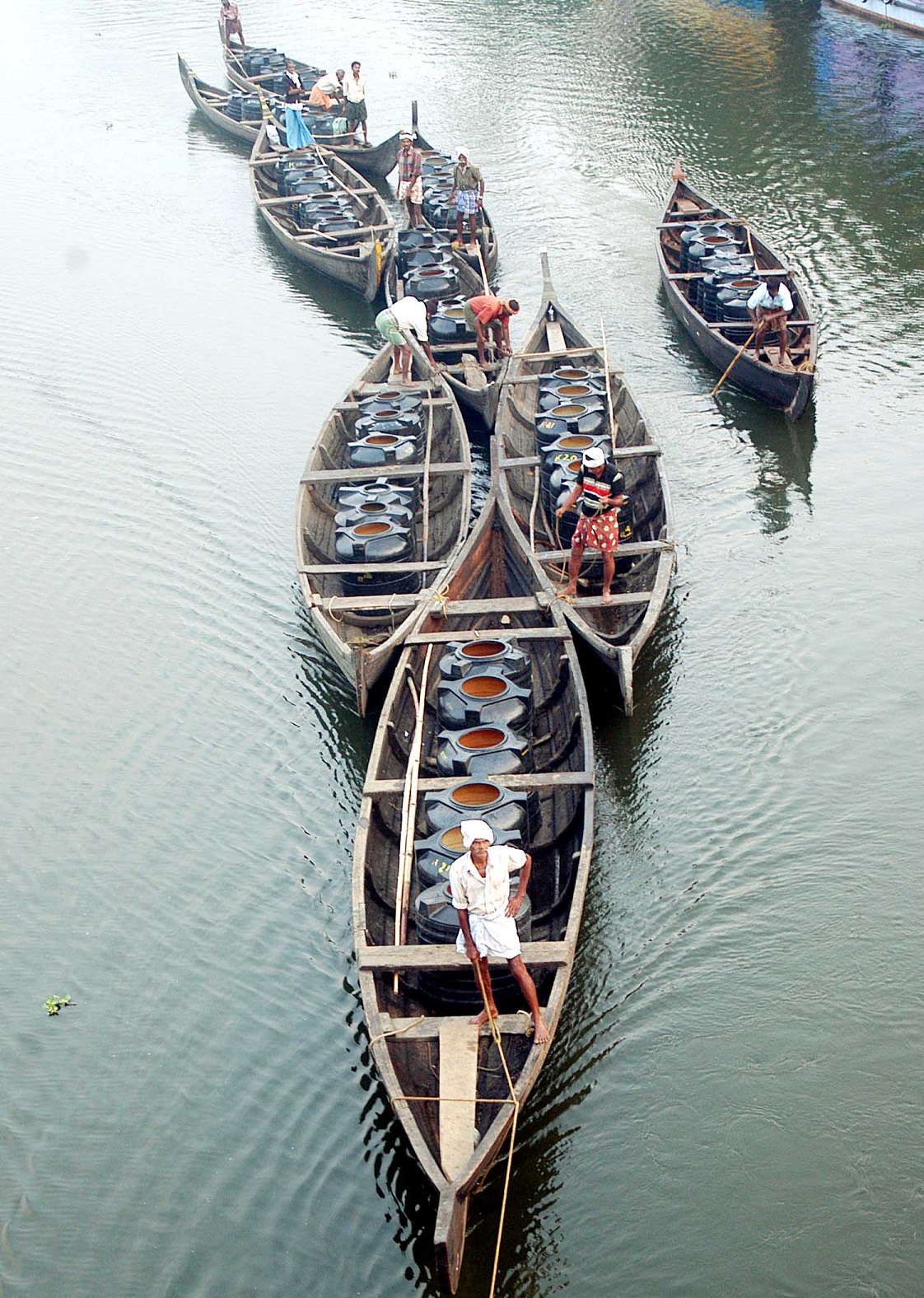
Photo courtesy: Muralikrishnan Alappuzha











